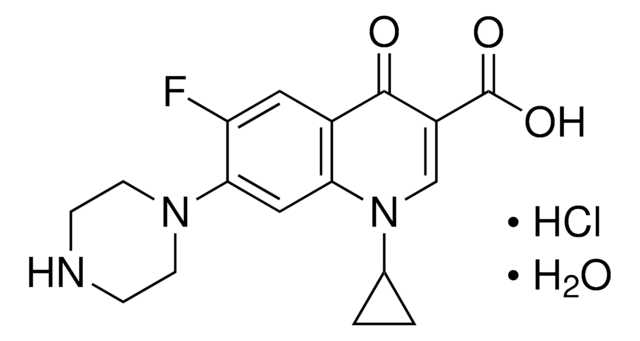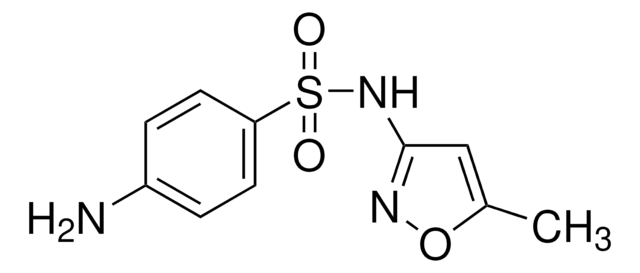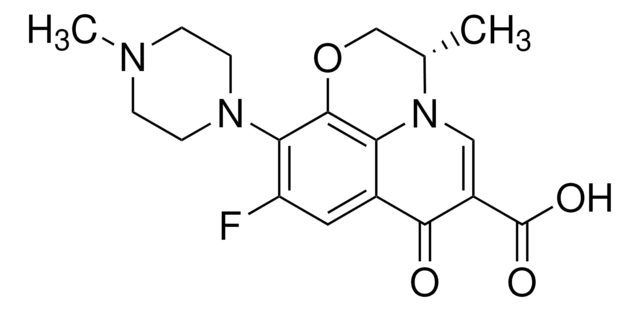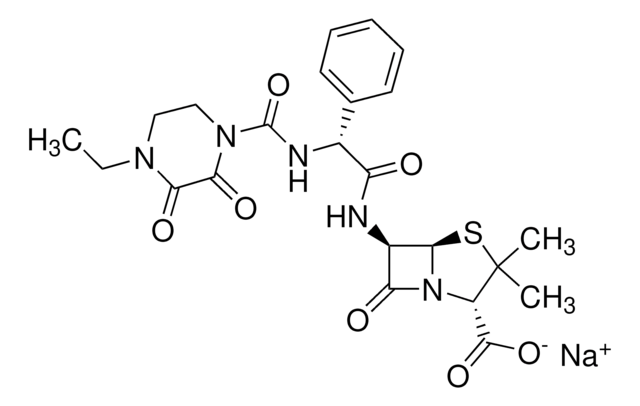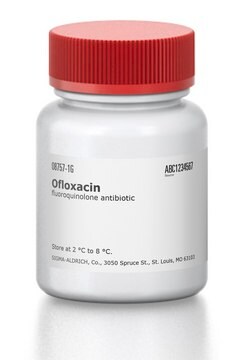추천 제품
Agency
EPA 1694
Quality Level
분석
≥98% (HPLC)
양식
powder or crystals
항생제 활성 스펙트럼
Gram-negative bacteria
Gram-positive bacteria
응용 분야
environmental
동작 모드
DNA synthesis | interferes
enzyme | inhibits
SMILES string
OC(=O)C1=CN(C2CC2)c3cc(N4CCNCC4)c(F)cc3C1=O
InChI
1S/C17H18FN3O3/c18-13-7-11-14(8-15(13)20-5-3-19-4-6-20)21(10-1-2-10)9-12(16(11)22)17(23)24/h7-10,19H,1-6H2,(H,23,24)
InChI key
MYSWGUAQZAJSOK-UHFFFAOYSA-N
유전자 정보
human ... CYP1A2(1544) , KCNH1(3756)
rat ... Gabra1(29705)
유사한 제품을 찾으십니까? 방문 제품 비교 안내
관련 카테고리
일반 설명
Ciprofloxacin is a second-generation broad-spectrum fluoroquinolone antibiotic with extensive antimicrobial and pharmacokinetic properties that is widely used to combat bacterial infections. Its chemical name is 1-cyclopropyl-6-fluoro-4-oxo-7-(piperazin-1-yl)-1,4-dihydroquinoline-3-carboxylic acid.
Chemical structure: fluoroquinolone
Chemical structure: fluoroquinolone
애플리케이션
Ciprofloxacin is widely used in clinical practices against Gram-positive and Gram-negative bacteria and the treatment of a broad range of infections, including those of the skin, eyes, urinary tract, lower respiratory tract, gastrointestinal tract, et cetera. It can also be combined with various antimicrobial agents to combat bacterial biofilms as well as multidrug-resistant microorganisms. Its derivatives have been developed to synthesize novel antibacterials with enhanced potency and diverse antimicrobial effects including antibacterial, antifungal, anti-HIV, anti-tumor, and anti-TB properties.
생화학적/생리학적 작용
The mechanism of action of Ciprofloxacin is the inhibition of bacterial DNA synthesis by blocking the subunit A of DNA gyrase enzyme as well as by affecting the bacterial cell wall.
Storage Class Code
11 - Combustible Solids
WGK
WGK 2
개인 보호 장비
Eyeshields, Gloves, type N95 (US)
이미 열람한 고객
Athina Andrea et al.
Microorganisms, 7(3) (2019-03-22)
Among non-mammalian infection model organisms, the larvae of the greater wax moth Galleria mellonella have seen increasing popularity in recent years. Unlike other invertebrate models, these larvae can be incubated at 37 °C and can be dosed relatively precisely. Despite
Elena B M Breidenstein et al.
Antimicrobial agents and chemotherapy, 52(12), 4486-4491 (2008-10-01)
Pseudomonas aeruginosa offers substantial therapeutic challenges due to its high intrinsic resistance to many antibiotics and its propensity to develop mutational and/or adaptive resistance. The PA14 comprehensive mutant library was screened for mutants exhibiting either two- to eightfold increased susceptibilities
Orjan Samuelsen et al.
Antimicrobial agents and chemotherapy, 54(1), 346-352 (2009-11-04)
Scandinavia is considered a region with a low prevalence of antimicrobial resistance. However, the number of multidrug-resistant (MDR) Gram-negative bacteria is increasing, including metallo-beta-lactamase (MBL)-producing Pseudomonas aeruginosa. In this study MBL-producing P. aeruginosa isolates identified in Norway (n = 4)
Li-Yang Hsu et al.
Antimicrobial agents and chemotherapy, 54(3), 1173-1178 (2010-01-13)
A surveillance study was performed in four Singapore public hospitals from 2006 to 2008 to determine the correlation between antibiotic prescription and Gram-negative bacterial antimicrobial resistance. Targeted organisms included ceftriaxone- and ciprofloxacin-resistant Escherichia coli and Klebsiella pneumoniae, as well as
Dongeun Yong et al.
Antimicrobial agents and chemotherapy, 53(12), 5046-5054 (2009-09-23)
A Swedish patient of Indian origin traveled to New Delhi, India, and acquired a urinary tract infection caused by a carbapenem-resistant Klebsiella pneumoniae strain that typed to the sequence type 14 complex. The isolate, Klebsiella pneumoniae 05-506, was shown to
자사의 과학자팀은 생명 과학, 재료 과학, 화학 합성, 크로마토그래피, 분석 및 기타 많은 영역을 포함한 모든 과학 분야에 경험이 있습니다..
고객지원팀으로 연락바랍니다.
